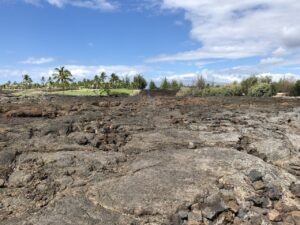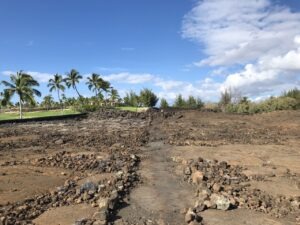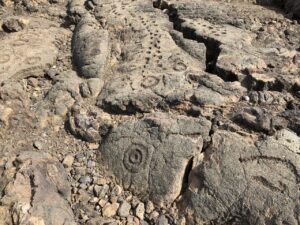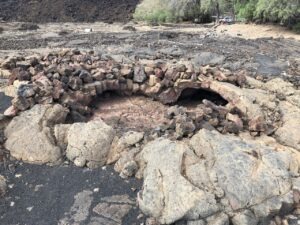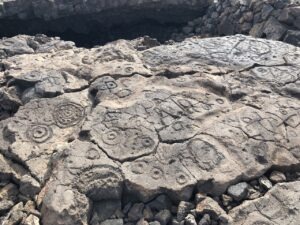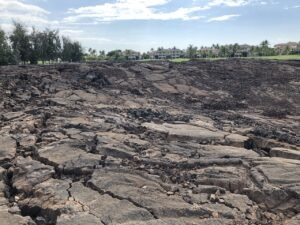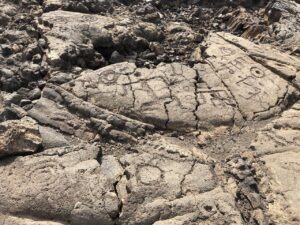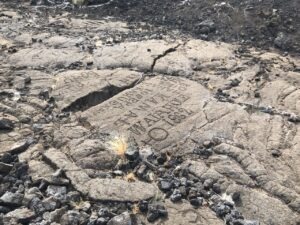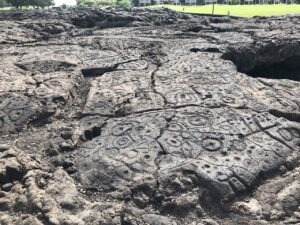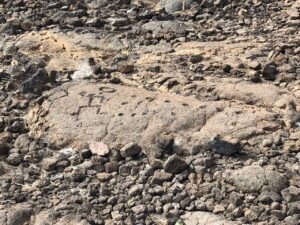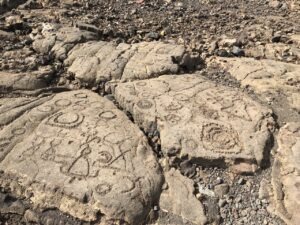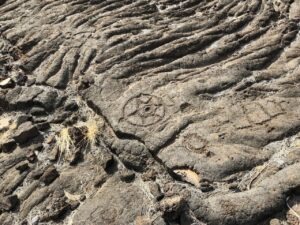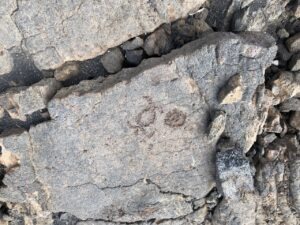During my stay on Hawaii’s Big Island, I was fortunate enough to explore Waikoloa Petroglyph Field, which is an amazing site filled with ancient petroglyphs. Visitors are able to walk a path on the lava rock and, ultimately, be surrounded by thousands of these enigmatic carvings. While their exact meanings are not entirely known, the petroglyphs are historical and cultural treasures that I was thrilled to experience.
The Waikoloa Petroglyph Field inconspicuously lies among a golf course, resort, and shopping center. My hunch is that many tourists pass this site by without realizing it’s there. The field sits on the King’s Trail, which was built in the mid-1800s and was part of a large road system. Some of the petroglyphs, also known as k’i’i pohaku, were carved after the creation of the trail and others were there long before it. While the most recent petroglyph is from 1900, the earliest one was apparently dated to the year 840. If this is the case, the petroglyphs at this site span a staggering range of over 1100 years.
In ancient times, the field’s location was the border between the kingdoms of Kona and Kohala. Because of this, various groups of people would have spent time here. They may have included travelers waiting for permission to cross, or armies positioned to defend or invade. While camped at the border, those people made markings upon the stone. Additionally, the remains of stone windbreaks can be seen at the site.
Of course, one naturally wonders what the symbols mean. Unfortunately, there are no definitive answers. For example, in the early 1800s, Rev. William Ellis was told that dots and circles indicated a travel party’s full journey around the island. A semi-circle indicated a partial journey. However, in the early 20th century, anthropologist Martha Beckwith stated that the dots indicated the birth of children, while a dot inside a circle indicated a first-born. Two circles meant it was the child of a chief. So, there are conflicting explanations. The impact of European contact can also be seen in some of the petroglyphs, most obviously those that include letters from the Latin alphabet. Ultimately, we are left to wonder.
The Waikoloa Petroglyph Field is also known as the ‘Anaeho’omalu Petroglyph Field, the Waikoloa Petroglyph Preserve, and the Waikoloa Petroglyph Reserve. Parking at the east side of the Kings’ Shops shopping center will provide easy access to the King’s Trail, which passes through the field. Head north on the trail and follow the signage for directions and rules. The signs recommend sturdy shoes and I agree. The trail can be rocky, so walking slowly and carefully is important. There’s no shade on the field, so please keep sun safety and hydration in mind. I’ve heard it said that the petroglyphs are easier to see earlier and later in the day since the angle of the sun better casts shadows. As of writing this, access to the site is free.
I was very happy to have visited the Waikoloa Petroglyph Field while staying on the Big Island. To be surrounded by thousands of these enigmatic carvings was just incredible. It is a fascinating view into Hawaii’s ancient past.
Location
Waikoloa Petroglyph Field
Waikoloa Beach Drive
Waikoloa Village, HI 96738
Sources
“Explore the Waikoloa & Puako Petroglyphs.” Big Island Guide. https://bigislandguide.com/waikoloa-puako-petroglyphs.
Kearns, Margaret. “Hawaiian Petroglyphs Tell Stories of the Past.” Ke Ola Magazine, Sept 2012. https://keolamagazine.com/culture/hawaiian-petroglyphs/.
“Pu‘uloa Petroglyphs.” National Park Service. https://www.nps.gov/havo/learn/historyculture/puuloa.htm?sid=55oV8u.
“The Waikoloa Petroglyph Field.” The Historical Marker Database. https://www.hmdb.org/m.asp?m=4247.
Written by A. P. Sylvia

